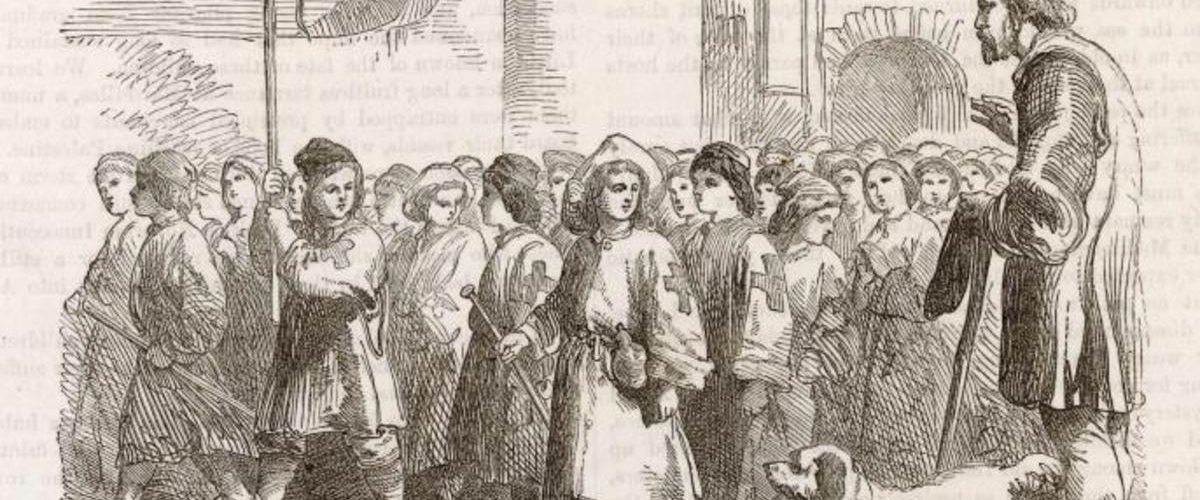Centuries after the Crusades, many American Christians still feel the urge to fight for power, control and dominion over what they believe is God’s country. But with a Constitution that protects religious freedom, what are modern crusaders really fighting for?
The Children’s Crusade occurred in the year 1212, according to medieval Christian accounts. Large groups of pueri — a Latin word translated “children” that also figuratively can refer to the “powerless” — left their daily agricultural work in Germany and France to become crusaders.
No firsthand reports of the Children’s Crusade still exist. But several medieval authors agree the pueri were from low social classes. Child or adult, they represented society’s most economically and socially powerless.
Historians believe the Children’s Crusade began in Chartres, France, where a strong crusading mentality had festered since the First Crusade in 1095. Enthusiasm for crusading had increased in popularity over the decades since the Cult of Carts Crusade in 1145. Customarily, leaders traveled across this part of Europe, recruiting soldiers to battle in defense of the Holy Land, which was occupied by Muslims.
Their constant preaching and promotion of crusading normalized the practice in years leading up to the Children’s Crusade. Constant community recruitment for the 1208 Albigensian Crusade and the 1211-1212 Spanish Crusade spurred dramatic feelings of support and conviction that God ordained these wars.
“Longing for a return to Christian control over the Holy Land, Crusaders believed they were fighting in the Lord’s army.”
Longing for a return to Christian control over the Holy Land, Crusaders believed they were fighting in the Lord’s army.
Crusading mentality: Power for the powerless
Deciding to become a crusader was an easy choice for society’s lowest classes, since crusading did not require formal education or wealth. Due to the public’s support of the Crusades as holy wars, crusaders enjoyed social prestige. For members of society’s lowest classes, becoming a crusader provided an opportunity to escape a life of generational poverty and social denigration.
As crusaders, the pueri could be considered pauperes Christi — Latin for “Christ’s poor” — socially elevated by their fight for the divine cause of recapturing the Holy Land. Society’s outcasts could reinvent themselves and attain an undeniably honorable social identity by choosing to become crusaders.
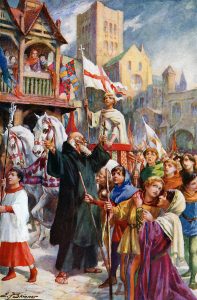
“The Childrens’ Crusade of 1212′” (c1920). Illustration from Story of the British Nation, Volume I, by Walter Hutchinson, (London, c1920s). (Photo by The Print Collector/Print Collector/Getty Images)
But despite the growing enthusiasm for crusading and its possible benefits, the medieval crusaders’ conviction that military force was the God-ordained method for defending the Holy Land proved violent and unsuccessful.
Many crusaders never returned home, often dying or suffering severe abuse before ever reaching the Holy Land. Historians of the Children’s Crusade believe the pueri who did survive battle were subject to enslavement and abuse by opposing armies who captured them.
Over time, desperation developed.
The crusading culture insisted these militaristic attempts to take back the Holy Land was the ordained mission of God’s people. Yet a sense of triumph or reward did not exist. Despite these failures, the desire to crusade persisted.
Even after repeated failures, crusaders believed their actions were under God’s ordinance. Consequently, they thought they eventually would triumph and take back the Holy Land. To justify the high numbers of crusader deaths, they associated fighting in the Lord’s Army with the reward of God’s care. Crusaders would either boast of victory or rest in the promise of immediate salvation in death, bypassing years in purgatory to enter straight into heaven.
Rather than accept a future of generational poverty, the pueri of 1212 may have realized that, although there was the slim prospect of social notoriety following survival, their death would lead them to an eternal paradise far more enjoyable than the powerless life they were leading.
Crusading mentality: Fighting against the ‘other’
In addition to personal motivations, the belief that Muslims occupying the Holy Land were the despicable “other” provided an essential component of crusading mentality.
For example, Christians called Muslims barbarae nationes — Greek for “barbarians” — an ethnocultural term used in antiquity to distinguish those who participated in urban civilization from those who were alien to it. Within the context of medieval crusading, the term distinguished Western Latin crusaders from others in terms of language and culture, asserting Christian culture’s ultimate superiority.
Crusaders also employed multiple religiously othering labels to describe or name Muslims, such as “pagans,” “Gentiles,” “infidels” or “enemies of God.”
These labels distinguished the difference between Muslim religious practices and Christian religious practices. Crusaders theologically justified Muslims as enemies in the Holy War by fabricating negative, seemingly heretical, images of their religious culture. Crusaders believed Muslim religious practice to be sinful, juxtaposing Christian morality against Muslim practice and further justifying the war.
Consequently, an event like the Children’s Crusade may have represented an effort to pit Christianity’s most innocent and pure against its heretical enemy. And since other European Christians saw them as protected by God, the children and the poor may have been recruited under the theological assumption that, unlike other military demographics, their powerlessness would promise their survival.
A military made up of pueri may have embodied a desperate attempt at calling upon God’s favor in these supposedly Holy Wars. But despite this grasp for victory, the pueri’s crusading narrative tells a different story.
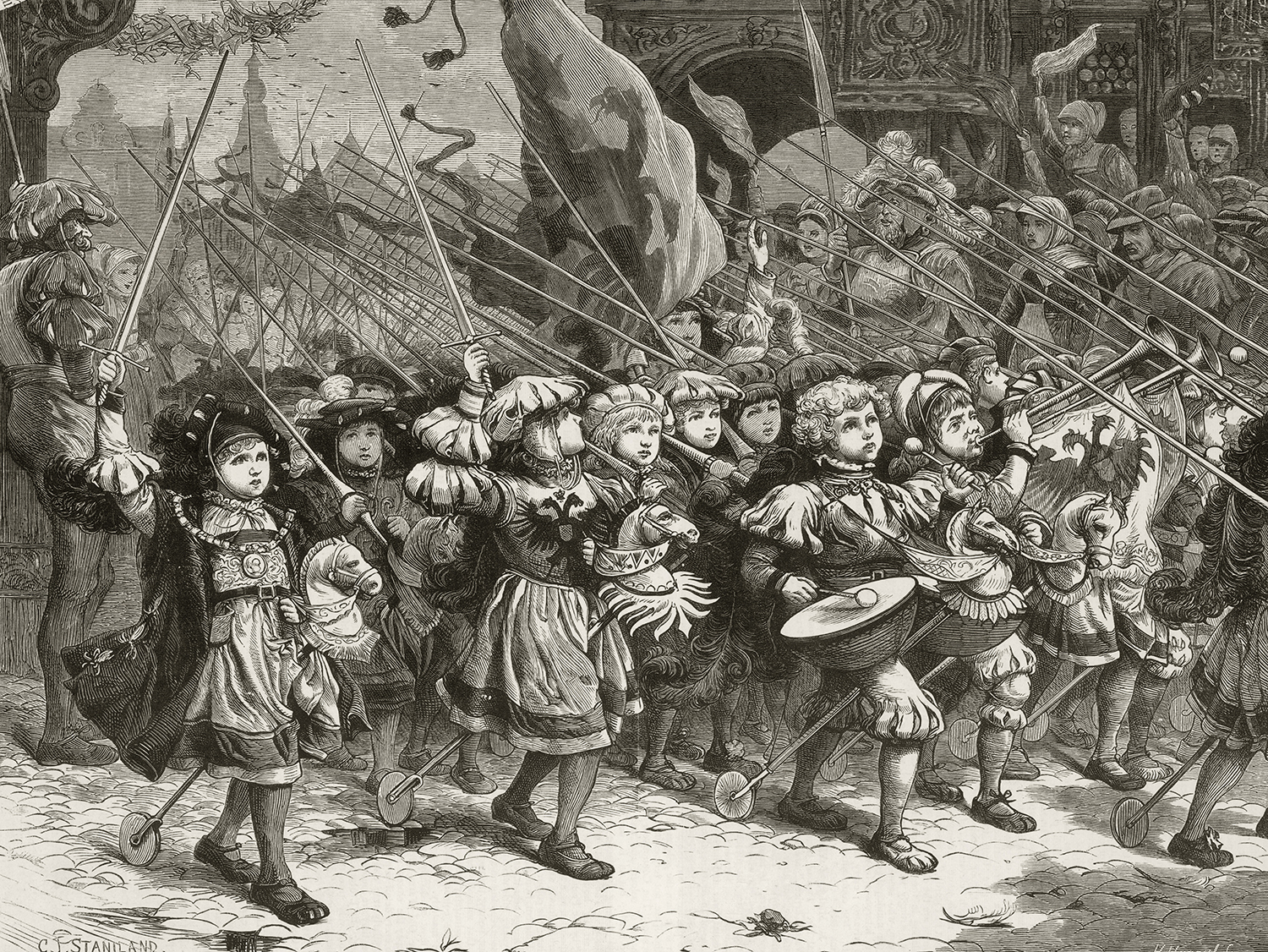
Illustration of a group of children, known as the Cockhorse Regiment, who took part in the children’s crusade of 1212. (Photo by Hulton Archive/Getty Images)
Narratives of the Children’s Crusade
With no firsthand reports of the Children’s Crusade, the story must be pieced together from retellings by authors in France and Germany. The Children’s Crusade gets its name from the belief that the army of crusaders was led by a child and made up of children, although some texts disagree.
According to one story in the Royal Chronicle of Cologne, the crusaders were “still just youngsters.” Other reports were less charitable. A narrative in the Annals of Marbach claims the event began when a “stupid multitude” made up of both children and adults became crusaders.
The Anonymous Chronicle of Laon describes how Stephen of Cloyes, traditionally understood as the Children’s Crusade leader, claimed the Lord appeared to him in a vision. Then he gathered “nearly thirty-thousand people” in France to join him. In a German account, the leader of the Children’s Crusade is a boy named Nicholas, considered holy like Stephen, who gathered with children from all around Germany and “united into a troop” to recapture the Holy Land.
An account from Pope Innocent III recalls “many thousands of boys, ranging in age from six years to full in maturity,” rising in groups on a journey to Jerusalem as crusaders, despite pleas from their loved ones to stop. According to Innocent, the crusade was not promoted but was divinely inspired among participants.
“One thing is for sure: that of the many thousands who rose up, only very few returned.”
The pope remarked, “One thing is for sure: that of the many thousands who rose up, only very few returned.”
Matthew Paris, a Benedictine monk, also recalled the event but spoke negatively of the children, asserting a false doctrine inspired them. In his account, no survivors remained.
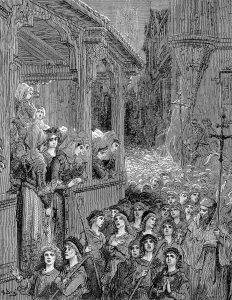
The Children’s Crusade, by Gustave Doré
Accounts claim the Children’s Crusade was a divinely inspired uprising of poor young people, perhaps joined by adults, who called themselves crusaders. Authors agree the outcome of their efforts was in vain. They did not reach the Holy Land, many died or were enslaved, and few, if any, returned home.
A survey of these accounts also demonstrates that, even during the medieval era when crusading was a normalized practice, people held mixed feelings about the purpose and outcome. These Christian recollections and responses to the Children’s Crusade reveal people grappled with the paradox of popular support for the Crusades and the visible reality of their failure. If God truly ordained these wars, why had the Christians not achieved their mission?
But this crusading mentality was not restricted to the medieval era.
Modern crusading mentality
Notions of God-sanctioned war and the existence of heretical counter-cultural enemies have remained common themes across the history of Christianity. Taught throughout the generations of the church, children have been reared with these values at the center of their religious beliefs and moral understandings.
For example, the popular children’s song “I’m in the Lord’s Army” compares the experience of fighting as a soldier in war to practicing Christianity: “I may never fight in the infantry / Ride in the cavalry / Shoot the artillery / I may never fly o’er the enemy / But I’m in the Lord’s army.”
The lyrics do not explain what enlistment in “the Lord’s army” means, allowing listeners and singers to make their own interpretive assumptions. But while the song does not place children directly in the line of military fire, child singers learn their faith is intrinsically connected with God-sanctioned war, violence and, subsequently, God-ordained triumph.
While the song serves as a metaphor for children — equating the struggles and hardships of spiritual faith to being at war on God’s side — its use of war imagery promotes thoughts of real battle. It implies one must fight with (and triumph over) an enemy in order to be a good Christian. And the idea that an “enemy” is required encourages children to consider who the “other” might be in the context of their Christian faith, just like crusaders.
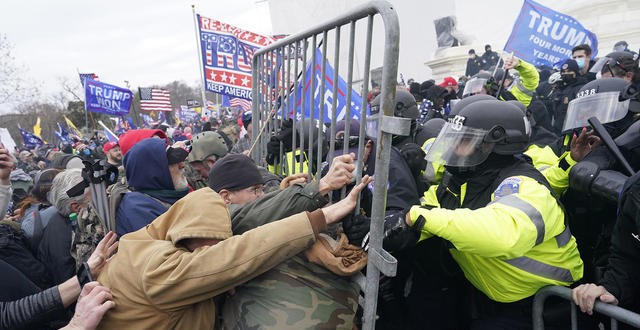
Law enforcement officers attempt to block rioting supporters of Donald Trump from breeching the U.S. Capitol on Jan. 6, 2021. (via CBS News)
The use of God-sanctioned war and violence and God-ordained triumph as common themes throughout the life of the church perpetuates the crusading mentality of the medieval era. Modern Christians continue their search for ideological, theological and social enemies to be defeated in the Lord’s name.
This mentality has led to modern versions of Holy Wars, especially among American Christians who believe they must dominate a country plagued with “culture wars” and place it under Christianity’s control. For example, the attitude that the most morally upright leader — whoever aligns most closely with Christianity — should be elected as the U.S. president is pervasive among American Christians.
For example, when Donald Trump lost the presidential election in 2020, those who believed he had been ordained by God could not comprehend he lost and declared the election “stolen.”
“Trump’s January 6 speech paralleled medieval community leaders’ use of sermons to recruit crusaders to take back the Holy Land.”
Characteristic of the medieval crusading mentality, insurrectionists attempted to overtake the Capitol violently. Trump’s January 6 speech paralleled medieval community leaders’ use of sermons to recruit crusaders to take back the Holy Land. It proved to be an essential, inspiring factor for the insurrectionists’ recruitment to take back the capitol. After listening to Trump, they felt their mission was justifiably God-sanctioned.
And just as the medieval crusading mentality held on with desperation despite many failed attempts to eradicate the heretical other, the failure of Trump’s insurrectionists only made his believers more desperate to eradicate the democratic other.
Crusading as Christian nationalism
Although “Christian nationalism” was not applied to the medieval era, both crusading mentalities are emblematic of the frenzy that ensues when Christian nationalists lose control and desperately claim God’s ordinance over a land, people or culture they want to overpower.
Unlike the medieval pueri who represented the impoverished agricultural workers and community peasants — the poorest and powerless — reports show Trump’s crowd predominantly was composed of business owners, CEOs and white-collar professionals, like doctors and lawyers. Although they may call themselves today’s pueri, their perceived lack of power stems from the fear they may lose what control they already have. Their desperation comes from a much more privileged position.
A position, perhaps, that God sanctions fighting when the power and control they already hold are threatened. A mission to justify their power by naming all others heretical, and a crusading mentality that requires all others fall so they may triumph.
But is God really ordaining this mission? Has the American Holy Land really been overtaken by a heretical, democratic other?
Trump’s pueri may believe they are in the Lord’s army, but crusading history tells a different story. Although assertions of God’s ordinance may recruit powerful armies, treating the God of peace as a weapon who will eradicate enemies never seems to end well.

Mallory Challis
Mallory Challis is a master of divinity student at Wake Forest University School of Divinity. She is a graduate of Wingate University and a former Clemons Fellow with BNG.
Related articles:
Today’s evangelicals are medieval crusaders at heart
The medieval Crusades, Billy Graham and American evangelicals
The root of the problem? Christian nationalism, panelists say
American Idolatry: How Christian nationalism betrays the gospel and threatens the church


